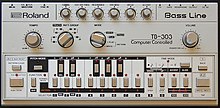

| Roland TB-303 Bass Line | |
|---|---|

TB-303 front panel
| |
| Manufacturer | Roland |
| Dates | 1981–1984 |
| Price | UK £238 (£1152 in 2023), US $395 ($1324 in 2023) |
| Technical specifications | |
| Polyphony | monophonic |
| Timbrality | monotimbral |
| Oscillator | Sawtooth and square wave |
| LFO | none |
| Synthesis type | Analog subtractive |
| Filter | 24 dB/oct low-pass resonant filter, non-self-oscillating |
| Aftertouch expression | No |
| Velocity expression | No |
| Storage memory | 64 patterns, 7 songs, 1 track |
| Effects | No internal effects. |
| Input/output | |
| Keyboard | 16 pattern keys |
The Roland TB-303 Bass Line (also known as the 303) is a bass synthesizer released by Roland Corporation in 1981. Designed to simulate bass guitars, it was a commercial failure and was discontinued in 1984. However, cheap second-hand units were adopted by electronic musicians, and its "squelching" or "chirping" sound became a foundation of electronic dance music genres such as acid house, Chicago house and techno. It has inspired numerous clones.
The TB-303 was manufactured by the Japanese company Roland. It was designed by Tadao Kikumoto, who also designed the Roland TR-909 drum machine.[1] It was marketed as a "computerised bass machine" to replace the bass guitar.[2] However, according to Forbes, it instead produces a "squelchy tone more reminiscent of a psychedelic mouth harp than a stringed instrument".[3]
The TB-303 has a single oscillator, which produces either a "buzzy" sawtooth wave or a "hollow-sounding" square wave.[3] This is fed into a 24 dB/octave[4] low-pass filter, which is manipulated by an envelope generator.[2] Users program notes and slides using the internal sequencer.[3]
The TB-303's unrealistic sound made it unpopular with its target audience, those who wanted to replace bass guitars. It was discontinued in 1984,[5] and Roland sold off remaining units cheaply. 10,000 units were manufactured.[3]
The first track to use the TB-303 and enter the top ten of the UK Singles Chart was "Rip It Up" (1983), by the Scottish band Orange Juice.[6] Charanjit Singh's 1982 album Synthesizing: Ten Ragas to a Disco Beat was another early use of a TB-303, alongside another Roland device, the TR-808 drum machine. The album remained obscure until the early 21st century, when it was reissued and recognized as a precursor to acid house.[7]
The Chicago group Phuture bought a cheap TB-303 and began experimenting. By manipulating the synthesizer as it played, they created a unique "squelching, resonant and liquid sound". This became the foundation of the single "Acid Tracks", which was released in 1987 and created the acid genre. Acid, with the TB-303 as a staple sound, became popular worldwide, particularly as part of the UK's emerging rave culture known as the second summer of love.[3]
In the late 1980s and early 1990s, as new acid styles emerged, the TB-303 was often overdriven, producing a harsher sound, such as on Hardfloor's 1992 EP "Acperience" and Interlect 3000's 1993 EP "Volcano".[8] In 1995, the TB-303 was distorted and processed on Josh Wink hit "Higher State of Consciousness"[4][9] and on Daft Punk's "Da Funk".[10]
In 2011, the Guardian named the release of the TB-303 one of the 50 key events in the history of dance music.[5] The popularity of acid caused a dramatic increase in the price of used 303 units.[3] As of 2014, units sold for over £1,000.[11]
The TB-303 has inspired numerous software emulations and clones,[12] such as the TD-3 by Behringer, released in 2019.[13] In 2014, Roland released the TB-3 Touch Bassline, with a touchpad interface and MIDI and USB connections.[14] In 2017, Roland released the TB-03, a miniaturized model featuring an LED display and delay and overdrive effects.[15]
|
| ||
|---|---|---|
| Synthesizers |
| |
| Electronic drums |
| |
| Keytars |
| |
| Grooveboxes |
| |
| Samplers |
| |
| Workstations |
| |
| Sequencers |
| |
| MIDI interfaces |
| |
| Modules |
| |
| Software |
| |
| Amplifiers |
| |
| Effects units |
| |
| Organs |
| |
| Boss effects |
| |
| Founder |
| |
| Other |
| |